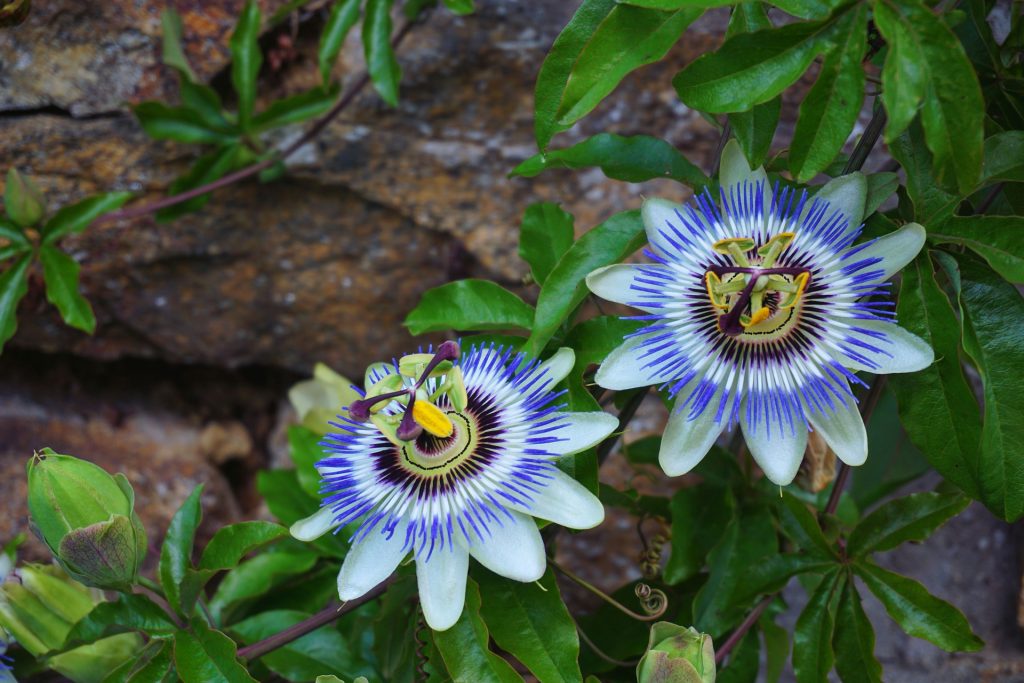 Flavonoids are a group of polyphenolic phytochemicals distributed throughout the plant kingdom. Luteolin is a flavonoid belonging to the flavone subclass. Chemically luteolin is referred to as (3′,4′,5,7-tetrahydroxyflavone). Flavones are an interesting group of flavonoids because evidence suggests that they can bind to the benzodiazepine receptors in the brains of animals and humans, and this may cause particular anxiolytic effects through the subsequent release of the relaxing and calming neurotransmitter GABA. Interestingly, luteolin is commonly found in plants that are used medicinally for their anxiolytic effects. For example, the lueolin is found in passionflower, casicum peppers, black nightshade, borage, vervain and ginkgo biloba, which are all known for their calming effects. Other flavones, particularly apigenin and chrysin are also commonly found in medicinally calming plants. Therefore the flavoned may comprise a group of medicinal useful anxiolytic agents that can be found naturally in many medicinal plants.
Flavonoids are a group of polyphenolic phytochemicals distributed throughout the plant kingdom. Luteolin is a flavonoid belonging to the flavone subclass. Chemically luteolin is referred to as (3′,4′,5,7-tetrahydroxyflavone). Flavones are an interesting group of flavonoids because evidence suggests that they can bind to the benzodiazepine receptors in the brains of animals and humans, and this may cause particular anxiolytic effects through the subsequent release of the relaxing and calming neurotransmitter GABA. Interestingly, luteolin is commonly found in plants that are used medicinally for their anxiolytic effects. For example, the lueolin is found in passionflower, casicum peppers, black nightshade, borage, vervain and ginkgo biloba, which are all known for their calming effects. Other flavones, particularly apigenin and chrysin are also commonly found in medicinally calming plants. Therefore the flavoned may comprise a group of medicinal useful anxiolytic agents that can be found naturally in many medicinal plants.

A number of commonly consumed plants have been shown to contain luteolin. Dietary sources of luteolin include carrots, peppers, celery, olive oil, peppermint, thyme, rosemary, sage and oregano. Honey can also contain luteolin, although this may depend on the plants visited by the bees, as some studies have shown that luteolin is not present in honey samples tested. Based on questionnaires, it was estimated in one study that the luteolin intake of subjects was 1.32 μg per day, with all of this intake coming from sage. As the dietary intake of luteolin is not as great as many other flavonoids it may be possible to significantly increase intake of luteolin by consuming medicinal herbs rich in the flavone. One of the best sources of luteolin is passionflower extract. Image shows passionflower.
Anti-anxiety effects for luteolin have been demonstrated in a number of animal models. For example in one study anxiolytic effects for luteolin were observed in mice. In another study, the anxiolytic effects of luteolin were also demonstrated in rats. The anti-anxiety effects of luteolin may be due to its ability to bind to the benzodiazepine receptor in the brain of mammals. However, this binding to the receptor is not strong and so other mechanisms may contribute to the anxiolytic effects of the flavonoid. One possibility is the stabilisation of neurones through antioxidant effect or alternatively, luteolin may interact with other neurotransmitter systems, particularly the serotonin system. However, it is possible that metabolites of luteolin may more strongly bind to the benzodiazepine receptor than the parent compound and so these metabolites of luteolin may stimulate the release of GABA in the brain, producing a calming effect. The exact way that luteolin can positively affect mood is therefore not fully understood.

Evidence suggests that luteolin is able to cross the blood brain barrier of mammals and enter the brain. Here luteolin may accumulate in tissues. In cell culture models, luteolin can significantly reduce neuronal cells death, and this may be due to the antioxidant and anti-inflammatory effects of the flavonoid. In particular, luteolin may be able to protect the delicate endoplasmic reticulum of cells in neurones, where protein neurotransmitters are formed. This may explain some of the neurochemical changes and health effects that luteolin is able to cause. Sage (pictured may be a dietary source of luteolin).
The antidepressant effects of luteolin have also been investigated in animal models. For example in one study, mice were administered corticosterone injections to simulate the release of stress hormones. Stress in known to be a significant factor in the development of depression. When administered corticosterone, the mice exhibited behaviour conductive to a stress response, including changes to eating behaviour. However administration of luteolin was able to reverse these changes indicating a significant anti-stress effect of the flavone. In combination with palmitoylethanolamide (PEA), a fatty acid that may function as an endocannabinoid, luteolin was shown to have significant antidepressant and anti-anxiety effects in the mice. In another study, the antidepressant effects of Cirsium japonicum in mice was shown to be due to the presence of luteolin in the extracts of the plant. Cirsium japonicum is a perennial plant belonging to the same family (Asteraceae) as daisy and camomile, which may explain its mood enhancing effects.
Eat Well, Stay Healthy, Protect Yourself
RdB
